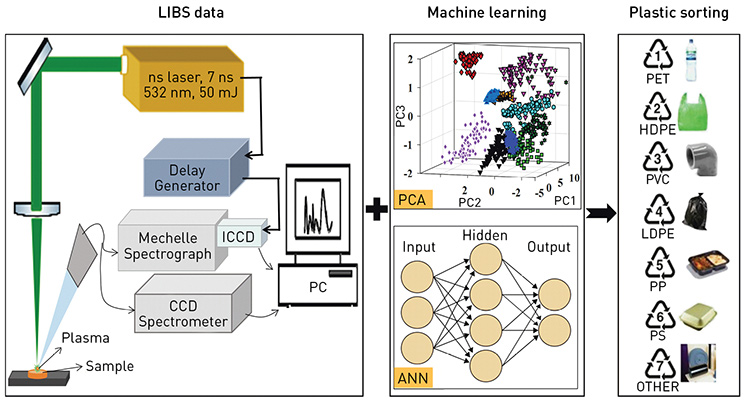 In the recently demonstrated system, data from a typical LIBS experimental setup (left) undergoes principal-component analysis (PCA) and artificial neural network (ANN) analysis (center), enabling identification and sorting of plastic waste (right).
In the recently demonstrated system, data from a typical LIBS experimental setup (left) undergoes principal-component analysis (PCA) and artificial neural network (ANN) analysis (center), enabling identification and sorting of plastic waste (right).
A staggering 50% of worldwide plastic production is used once and then disposed of, leading to pollution and depletion of natural resources.1 While recycling can help tackle this problem, accurate identification of plastic type is a crucial step to make it viable. Any mistake in identification can degrade the quality of the final product—with both commercial and scientific implications.2 Recently, we enlisted laser-induced breakdown spectroscopy (LIBS) and machine learning to create an approach for rapidly sorting plastic waste—at very low cost.3
Various laser-based methods for sorting plastics have been reported, but the color and thickness of the plastic greatly affect their performance.4 LIBS can help overcome many of the difficulties faced by conventional spectroscopic techniques, requires minimal sample preparation, and is capable of use in standoff scenarios. Yet most LIBS-based research reported on plastics classification has used pristine samples,5 and many experiments have employed an Echelle spectrograph coupled to an intensified charge-coupled device (ES-ICCD)—a relatively costly and bulky system that is unfavorable for real-time field applications.
Using spectroscopic data from a low-cost LIBS system, combined with machine-learning algorithms, we were able to rapidly identify ten different types of post-consumer plastics.3 The use of a Czerny Turner CCD spectrometer (CT-CCD) makes our system not only lightweight and compact but also cheaper, while single-shot signal acquisition makes the identification rapid. The use of a random forest algorithm for wavelength selection dramatically reduces the memory needed for storing the training data for machine learning, and also cuts the time needed for testing an unknown sample.
This system allowed us to demonstrate successful identification of post-consumer plastics with an average accuracy of around 97%.3 We also systematically investigated the effects of data acquisition conditions, spectrometers, signal-to-noise ratio and analytical approaches (principal component analysis, artificial neural network and random forest) on the identification accuracy and testing time. All the samples were collected from a recycling plant to simulate the conditions of a real-time application.
The analysis performed with the CT-CCD spectrometer has shown a roughly 15-fold reduction of overall identification time compared with the ES-ICCD for the single-shot acquisition. In a time as small as 10 ms, an unknown plastic was classified as one of the ten types used in our study. We believe that this work has great potential toward realizing a field-deployable, low-cost, compact LIBS system for rapid real-time sorting of plastic waste—and contributing to more efficient, viable plastics recycling.3
Researchers
Rajendhar Junjuri and Manoj Kumar Gundawar, University of Hyderabad, Hyderabad, Telangana, India
References
1. Y. Chae and Y.-J. An. Environ. Pollut. 240, 387 (2018).
2. G. Faraca and T. Astrup. Waste Manage. 95, 388 (2019).
3. R. Junjuri and M.K. Gundawar. Waste Manage. 117, 48 (2020).
4. N. Singh et al. Composites, Part B 115, 409 (2017).
5. K. Liu et al. TrAC, Trends Anal. Chem. 110, 327 (2019).
27 December 2020: A correction has been posted for this article.
